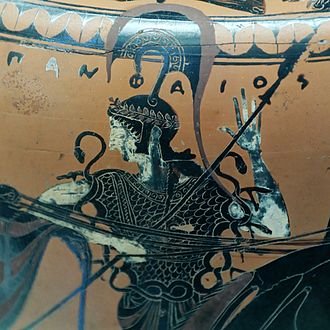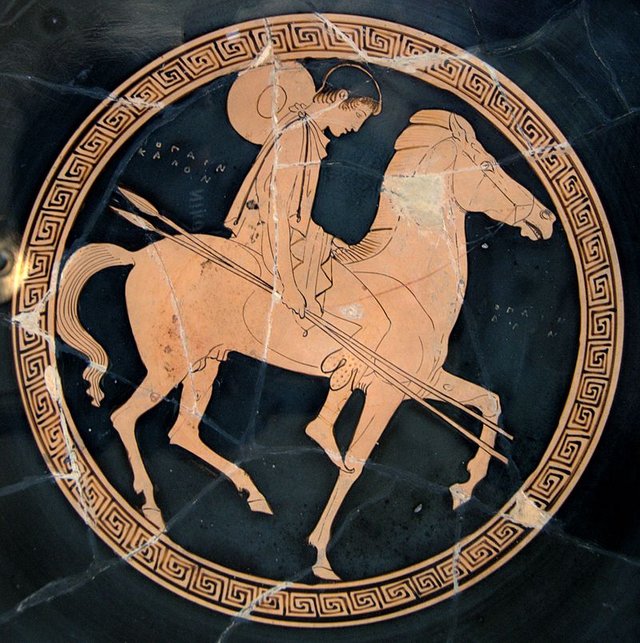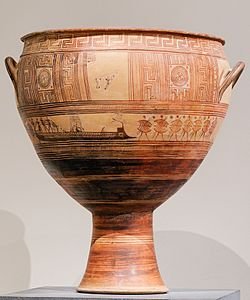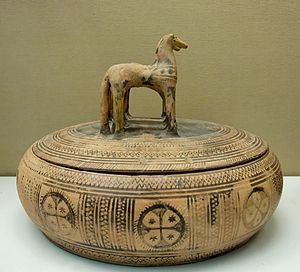Ancient Greek art
Greek architecture, technically very simple, established a harmonious style with numerous detailed conventions that were largely adopted by Roman architecture and are still followed in some modern buildings. It used a vocabulary of ornament that was shared with pottery, metalwork and other media, and had an enormous influence on Eurasian art, especially after Buddhism carried it beyond the expanded Greek world created by Alexander the Great. The social context of Greek art included radical political developments and a great increase in prosperity; the equally impressive Greek achievements in philosophy, literature and other fields are well known.
The earliest art by Greeks is generally excluded from ancient Greek art, and instead known as Aegean art; this includes Cycladic art and the art of the Minoan and Mycenaean cultures from the Greek Bronze Age. The art of ancient Greece is usually divided stylistically into four periods: the Geometric, Archaic, Classical, and Hellenistic. The Geometric age is usually dated from about 1000 BC, although in reality little is known about art in Greece during the preceding 200 years, traditionally known as the Greek Dark Ages. The 7th century BC witnessed the slow development of the Archaic style as exemplified by the black-figure style of vase painting. Around 500 BC, shortly before the onset of the Persian Wars (480 BC to 448 BC), is usually taken as the dividing line between the Archaic and the Classical periods, and the reign of Alexander the Great (336 BC to 323 BC) is taken as separating the Classical from the Hellenistic periods. From some point in the 1st century BC onwards "Greco-Roman" is used, or more local terms for the Eastern Greek world.[2]
In reality, there was no sharp transition from one period to another. Forms of art developed at different speeds in different parts of the Greek world, and as in any age some artists worked in more innovative styles than others. Strong local traditions, and the requirements of local cults, enable historians to locate the origins even of works of art found far from their place of origin. Greek art of various kinds was widely exported. The whole period saw a generally steady increase in prosperity and trading links within the Greek world and with neighbouring cultures.
The survival rate of Greek art differs starkly between media. We have huge quantities of pottery and coins, much stone sculpture, though even more Roman copies, and a few large bronze sculptures. Almost entirely missing are painting, fine metal vessels, and anything in perishable materials including wood. The stone shell of a number of temples and theatres has survived, but little of their extensive decoration.
Pottery
By convention, finely painted vessels of all shapes are called "vases", and there are over 100,000 significantly complete surviving pieces,[6] giving (with the inscriptions that many carry) unparalleled insights into many aspects of Greek life. Sculptural or architectural pottery, also very often painted, are referred to as terracottas, and also survive in large quantities. In much of the literature, "pottery" means only painted vessels, or "vases". Pottery was the main form of grave goods deposited in tombs, often as "funerary urns" containing the cremated ashes, and was widely exported.
The famous and distinctive style of Greek vase-painting with figures depicted with strong outlines, with thin lines within the outlines, reached its peak from about 600 to 350 BC, and divides into the two main styles, almost reversals of each other, of black-figure and red-figure painting, the other colour forming the background in each case. Other colours were very limited, normally to small areas of white and larger ones of a different purplish-red. Within the restrictions of these techniques and other strong conventions, vase-painters achieved remarkable results, combining refinement and powerful expression. White ground technique allowed more freedom in depiction, but did not wear well and was mostly made for burial.

Conventionally, the ancient Greeks are said to have made most pottery vessels for everyday use, not for display. Exceptions are the large Archaic monumental vases made as grave-markers, trophies won at games, such as the Panathenaic Amphorae filled with olive oil, and pieces made specifically to be left in graves; some perfume bottles have a money-saving bottom just below the mouth, so a small quantity makes them appear full.[8] In recent decades many scholars have questioned this, seeing much more production than was formerly thought as made to be placed in graves, as a cheaper substitute for metalware in both Greece and Etruria.[9]
Most surviving pottery consists of vessels for storing, serving or drinking liquids such as amphorae, kraters (bowls for mixing wine and water), hydria (water jars), libation bowls, oil and perfume bottles for the toilet, jugs and cups. Painted vessels for serving and eating food are much less common. Painted pottery was affordable even by ordinary people, and a piece "decently decorated with about five or six figures cost about two or three days' wages".[10] Miniatures were also produced in large numbers, mainly for use as offerings at temples.[11] In the Hellenistic period a wider range of pottery was produced, but most of it is of little artistic importance.
In earlier periods even quite small Greek cities produced pottery for their own locale. These varied widely in style and standards. Distinctive pottery that ranks as art was produced on some of the Aegean islands, in Crete, and in the wealthy Greek colonies of southern Italy and Sicily.[12] By the later Archaic and early Classical period, however, the two great commercial powers, Corinth and Athens, came to dominate. Their pottery was exported all over the Greek world, driving out the local varieties. Pots from Corinth and Athens are found as far afield as Spain and Ukraine, and are so common in Italy that they were first collected in the 18th century as "Etruscan vases".[13] Many of these pots are mass-produced products of low quality. In fact, by the 5th century BC, pottery had become an industry and pottery painting ceased to be an important art form.
The range of colours which could be used on pots was restricted by the technology of firing: black, white, red, and yellow were the most common. In the three earlier periods, the pots were left their natural light colour, and were decorated with slip that turned black in the kiln.[7]
Greek pottery is frequently signed, sometimes by the potter or the master of the pottery, but only occasionally by the painter. Hundreds of painters are, however, identifiable by their artistic personalities: where their signatures have not survived they are named for their subject choices, as "the Achilles Painter", by the potter they worked for, such as the Late Archaic "Kleophrades Painter", or even by their modern locations, such as the Late Archaic "Berlin Painter".[14]

History
The history of ancient Greek pottery is divided stylistically into five periods:
the Protogeometric from about 1050 BC
the Geometric from about 900 BC
the Late Geometric or Archaic from about 750 BC
the Black Figure from the early 7th century BC
and the Red Figure from about 530 BC
During the Protogeometric and Geometric periods, Greek pottery was decorated with abstract designs, in the former usually elegant and large, with plenty of unpainted space, but in the Geometric often densely covering most of the surface, as in the large pots by the Dipylon Master, who worked around 750. He and other potters around his time began to introduce very stylised silhouette figures of humans and animals, especially horses. These often represent funeral processions, or battles, presumably representing those fought by the deceased.
The Geometric phase was followed by an Orientalizing period in the late 8th century, when a few animals, many either mythical or not native to Greece (like the sphinx and lion respectively) were adapted from the Near East, accompanied by decorative motifs, such as the lotus and palmette. These were shown much larger than the previous figures. The Wild Goat Style is a regional variant, very often showing goats. Human figures were not so influenced from the East, but also became larger and more detailed.
The fully mature black-figure technique, with added red and white details and incising for outlines and details, originated in Corinth during the early 7th century BC and was introduced into Attica about a generation later; it flourished until the end of the 6th century BC. The red-figure technique, invented in about 530 BC, reversed this tradition, with the pots being painted black and the figures painted in red. Red-figure vases slowly replaced the black-figure style. Sometimes larger vessels were engraved as well as painted. Erotic themes, both heterosexual and male homosexual, became common.
By about 320 BC fine figurative vase-painting had ceased in Athens and other Greek centres, with the polychromatic Kerch style a final flourish; it was probably replaced by metalwork for most of its functions. West Slope Ware, with decorative motifs on a black glazed body, continued for over a century after. Italian red-figure painting ended by about 300, and in the next century the relatively primitive Hadra vases, probably from Crete, Centuripe ware from Sicily, and Panathenaic amphorae, now a frozen tradition, were the only large painted vases still made.


Source
Plagiarism is the copying & pasting of others work without giving credit to the original author or artist. Plagiarized posts are considered spam.
Spam is discouraged by the community, and may result in action from the cheetah bot.
More information and tips on sharing content.
If you believe this comment is in error, please contact us in #disputes on Discord
Hi! I am a robot. I just upvoted you! I found similar content that readers might be interested in:
https://en.wikipedia.org/wiki/Ancient_Greek_art
Congratulations @desiderio1995! You have completed the following achievement on the Steem blockchain and have been rewarded with new badge(s) :
Click on the badge to view your Board of Honor.
If you no longer want to receive notifications, reply to this comment with the word
STOPDo not miss the last post from @steemitboard: